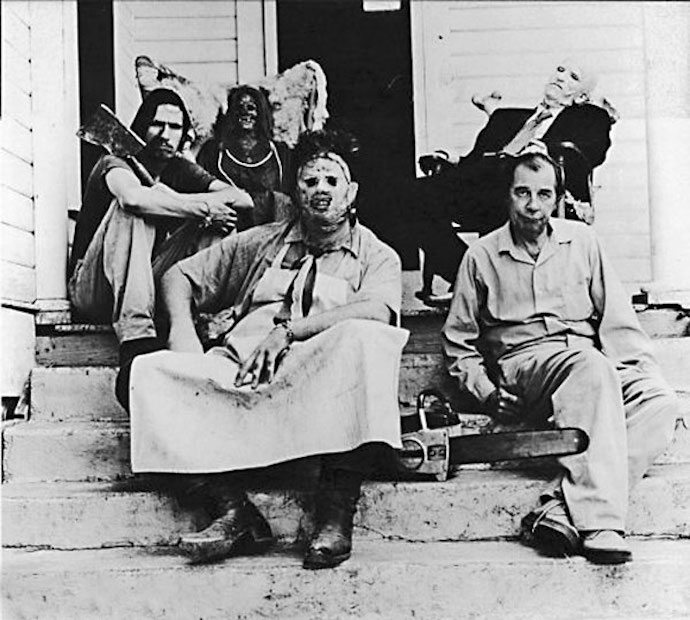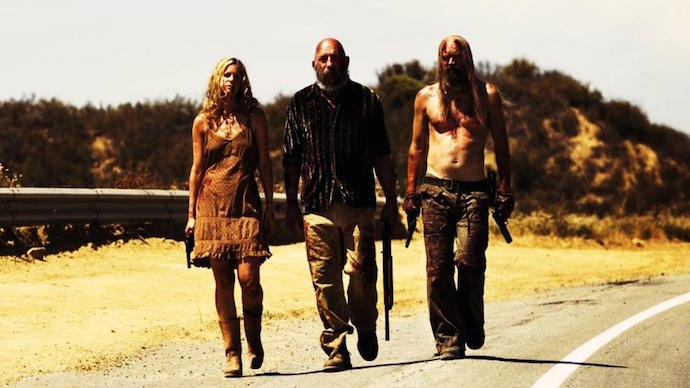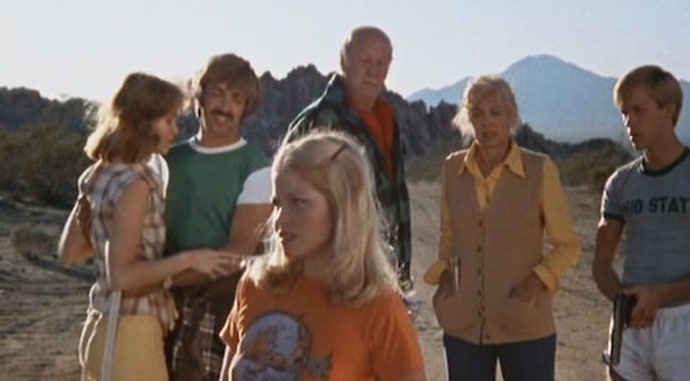On the Unholy Family in American Horror Film
16.11.15

In a remote but thriving corner of the American horror genre, the unholy family resides in secret, in a house far from others, surrounded by the totems and relics of a private order. Both persisting and degenerating through incest and cannibalism, the unholy family has been the basis of classic horror films ranging from Psycho (1960) to The Texas Chain Saw Massacre (1974) to The Hills Have Eyes (1977) to We Are What We Are (2013, based on a Mexican film from 2010), along with their many sequels and remakes. Throughout the past 50 years, as the nuclear American family and its attendant traditions have weakened, yielding both increased individual freedom and decreased communal stability, the unholy family has provided a cinematic counterpoint at once terrifying and strangely appealing.
The scandal underlying the Holy Family in Christian lore is that Jesus is the child of Mary and God, not Mary and Joseph, but Joseph is forced to play the role of father, thereby casting the family into denial. This is a scandal of too much outside blood, whereby God’s incomprehensible genetic influence invades the human family structure. The scandal underlying the unholy family is the opposite: that of too little outside blood, a lack of external genetic influence so extreme it causes the lines of siblings, parents, and children to cross in terrifying ways, to the point where the basic definition of humanity comes into question. While the Holy Family symbolizes how something genuinely new (a Messiah) enters the human race, the unholy family symbolizes oldness compounded, as incest endlessly copies the same genes inside a pressure chamber.
Sometimes the entropic force within this pressure chamber is congenital, as in the fictitious but plausible-sounding “Merrye Syndrome,” which causes the inbred children of the Merrye family in Spider Baby (1968) to revert to a state of “pre-natal savagery” as they age, or the actual condition of Kuru, which comes from eating human brain tissue and causes Parkinson’s-like symptoms in the cannibals of We Are What We Are. Elsewhere, it’s obsessional, as in Psycho, where Norman Bates’ relationship with his mother grows strained to the point of mental collapse when Marion Crane agitates his dormant libido, or in The People Under the Stairs (1991), where a girl on the brink of puberty is imprisoned by her parents (a brother/sister couple) in a gothic mansion above a basement full of mutilated, cannibalistic boys. In every case, it erupts into violence when the pressure chamber is violated.
***
Told from the perspective of a family of outsiders, each film discussed here dramatizes an encounter with the unholy family that culminates in its disintegration, cutting short its descent into the sub-human. This ensures that the unholy family only exists onscreen in a state of flux, never fully revealing its private nature, which, as outsiders ourselves, we cannot quite imagine. What we see instead is the effect that the unholy family has on the ostensibly normal family that stumbles across it, raising questions about American life that resonate well beyond the scope of any given film.
Unlike the outside family, which is shown in transit – often on a road trip –the unholy family lives, and seems to have always lived, in a secluded house, surrounded by an overgrown, forbidding yard. This is the Other House: the house where Norman Bates lives with, or as, his mother behind the motel in Psycho, the house where Leatherface and his family reside in TCSM, the satanic compound that gets raided in the opening scenes of The Devil’s Rejects (2005), and the house of the cannibalistic frontier revivalists in We Are What We Are, with its private graveyard on top of a hill in upstate New York. In The Hills Have Eyes, the unholy family takes over an entire New Mexico town, abandoned after nuclear testing rendered it uninhabitable.

Surrounding and somehow contextualizing the unholy family, the Other House also contains shrines, altars, and private museums, ranging from the chicken feathers and animal bones in TCSM, to the giant archive of murder photos in The Devil’s Rejects, to the ceremonial pot that the cannibals in We Are What We Are eat out of, to the pet tarantulas that one of the girls in Spider Baby calls forth and fondles in moments of agitation. If the unholy family has any sense of spirituality, it must be found in these objects, which outsiders can recognize but never relate to.
The Other House is Faulknerian in the way it combines haunting with twisted heredity, concentrating the past into a tangible essence in a way that only decrepit, isolated houses can. As it’s frequently impossible to tell who’s a parent, who’s a grandparent, and who’s a child, the Other House gives the impression that time itself has ceased to function within its walls. Inevitably, it also serves as the funhouse in which the films’ climactic violence plays out. With its rooms arranged as a series of increasingly dangerous arenas, it always has an innermost sanctum, usually the basement, where the most unutterable acts are committed and the most degenerate family members are kept: this is where Norman hides the fleshy skeleton of his mother, where Leatherface drags his victims to slot them onto meathooks, where the mutilated boys are kept in The People Under the Stairs, where the children whose disease is advanced beyond the limits of euphemism are hidden in Spider Baby, and where the meals-to-be are chained up in We Are What We Are. Though few outsiders make it this far down and even fewer reemerge, the basement contains the roots of the unholy family and the defining horror of these films.
***
Within this horror, unholy family films dramatize a genuine crisis in the American family structure. Unholy families appear outside of American film–Greek director Yorgos Lanthimos’ Dogtooth (2009), about a patriarch who keeps his wife and three children locked in a suburban compound, encouraging incest as a safeguard against the influence of an outside sexual surrogate, is a highbrow example of the genre – but the fear that the lives of our countrymen are indescribably different from our own is heightened in a nation that is both too vast to know in its entirety and supposedly predicated on the freedom of its citizens to live however they choose.
If the defining commonality among non-indigenous Americans is the feeling of newness and isolation, of our backgrounds being continually obscured and reinvented here, especially in major cities, then there’s a special horror in coming across rural families whose rootedness is overwhelming, who seem to have been right where they are, as an indivisible unit, since the beginning of time.
Unlike anthropological horror films like Cannibal Holocaust (1980), where travelers fall victim to terrifying natives on foreign continents, American unholy family films play on our simultaneous aversion and attraction to our own deep interior, positing that in the innermost reaches of the nation live people who will force us to question our basic assumptions about who and what Americans are. The absolute rootedness of the unholy family is thus both a siren song and an affront. It forces us to consider the alternative to roaming and reinvention, that of staying put through the generations and creating an Old World within the New, giving ultra-concentrated expression to our genetic core rather than opening the gene pool ever wider, as individuals in major cities inevitably do.
***

Even before encountering the unholy family, there is discord within the outside family–a bickering brother and sister visiting their grandfather’s grave in TCSM, a bourgeois couple mourning the death of their son in Last House on the Left (1972), two venal cousins determined to swindle the Merrye children out of their inheritance in Spider Baby, a passive-aggressive family road trip in The Hills Have Eyes, a detective fanatically determined to honor his “devil-slayer” lineage in The Devil’s Rejects, a boy from the LA ghetto trying to save his cancer-ridden mother in The People Under the Stairs, and Lila Crane investigating her sister’s disappearance in Psycho. Thus, the degree to which the unholy family forces the outside family to question its own nature is a magnification of a pre-existing crisis, not that crisis’ source. If the line between the outside family and the unholy family were absolute, these films would be simple freak shows. They become more than this when the members of the outside family begin to feel the power of the unholy stirring within themselves.
This feeling underlies the classic X-Files episode “Home” (1996), which finds Mulder and Scully investigating an unholy family that’s buried its deformed baby under a baseball field in Home, PA. The core drama here arises not from the unholy family itself but from the ways in which encountering it forces the agents to confront their own familial conflicts: in this case, Scully’s ambivalence about not being a mother, and Mulder’s desire to renounce his shiftless city life for the rural idyll of his youth. When Scully finds herself alone with the unholy family’s matriarch, deep in the Other House, the woman looks into her eyes and says, “I can tell you don’t have no children.” Scully’s reaction of involuntary shame and envy, far more than the woman’s rotten teeth and amputated legs, is the climax of the episode’s horror.
Here, as in the films, questions of what defines and what destroys a family grow oppressive as the outside family struggles to disentangle itself from the unholy family, and finds that its ability to do so is hampered by its uncertainty about its own nature. If these films have any moral statement, it’s that all families have the potential and perhaps the desire, both morally and genetically, to become unholy: all that’s required is time and isolation. The unholy family shows us our own genes magnified, not the genes of monsters. Though they play on folkloric stereotypes rather than scientific anxieties, unholy family films are closer to Cronenbergian body horror than to werewolf or vampire movies. As in Cronenberg’s work, their horror comes from grotesquely exaggerating real drives, rather than inventing new ones.
***
At the end of each film, the unholy family suffers some form of defeat. Sometimes this occurs when every member is killed (as in The Devil’s Rejects), sometimes when the outside family outruns its captors (as in TCSM), and sometimes – most interestingly – when the unholy family’s youngest generation is seduced by a glimmer of the outside world, as in We Are What We Are, which ends with the daughters of the cannibal patriarch eating their father before driving away from the Other House for good, and in The Last House on the Left, where the son of the unholy family’s patriarch helps the outside family kill his father and then asks to be adopted by them.
If the trajectory of undisturbed incest and hermetic ritual is too perverse or too mysterious to represent beyond a certain point, then the encounter with the outside family is designed to keep the unholy family from reaching this point, implicitly reassuring the viewer that it never will. There is undeniable relief in this, but there’s a sense of tragedy as well. More than simply dramatizing a showdown, these films interrogate, with extreme ambivalence, the notion that in the late 20th and early 21st centuries in America, family itself has come to be seen as animalistic and retrograde, and that being unencumbered and at-large is our only means of remaining human.
There are thus two distinct types of horror at play in these films: that which exists within the Other House, concentrated in the basement and manifested through deformity and savage violence, and that which exists within both the outside family and the viewer, roaming a land we can never civilize nor even comfortably inhabit, fleeing the past, forever afraid to go home. This is the horror of encountering the unholy family in the Other House and wishing we could stay.
——————
Films discussed:
Psycho (Alfred Hitchcock, 1960: A young man who is also his mother kills a woman who comes to stay at his motel.)
Spider Baby (Jack Hill, 1968: Moneygrubbing cousins come to the house of a family of inbred children trying to wheedle away their inheritance.)
The Texas Chainsaw Massacre (Tobe Hooper, 1974: A brother and sister and their friends revisit their grandfather’s grave in southeast Texas and fall victim to the cannibals living nearby.)
The Hills Have Eyes (Wes Craven, 1977 / Alexandre Aja, 2006: A family driving in a campervan through the New Mexico desert falls victim to a clan of fallout-mutated freaks.)
The People Under the Stairs (Wes Craven, 1991: A cash-strapped kid from the LA ghetto breaks into the house of a rich family and discovers a small army of mutilated boys imprisoned in the basement.)
The Last House on the Left (Wes Craven 1972 / Dennis Iliadis, 2009: A girl on summer vacation is raped and almost killed by a family of maniacs, who then seek shelter from a thunderstorm at the house of that girl’s vengeful parents.)
The Devil’s Rejects (Rob Zombie, 2005: After their compound is raided, a family of Satanists goes on the lam.)
We Are What We Are (Jim Mickle, 2013: A family of Frontier-reenacting cannibals in upstate New York starts to unravel after the matriarch dies of Kuru, a degenerative neurological disease.)
TV Episode:
Home (“The X-Flies,” Season 4, Episode 2, 1996. Mulder and Scully investigate a dead baby supposedly buried by an unholy family in Home, PA.)